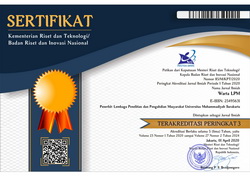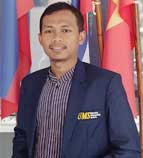Public Awareness of Air Pollution and Mitigation of Its Risk
Abstract
Purpose: This Community Partnership Program (PKM) aims to increase public awareness about the negative impacts of air pollution and how to mitigate it.
Methodology: handing over air pollution monitoring tools, counseling, and planting air pollution-reducing plants.
Results: the presence of counseling can increase understanding of the negative impacts of air pollution. Public awareness to mitigate the negative impact of air pollution has increased after attending counseling. For mitigating the negative impact of air pollution, the community will plant air pollution-reducing plants, service routinely their vehicle and reduce the use of vehicles.
Applications/Originality/Value: This community service program is based on the results of air pollution mapping in the city of Yogyakarta. Programs to raise public awareness about health risks due to air pollution are still rare in Yogyakarta and the importance of knowledge about ways to mitigate air pollution risks.
Downloads
References
Adawiyah, A.R., Arindita, N.D., Selviastuti, R., Yuliawati, S. 2013. Panda Sansevieria (Pengharum Ruangan Anti Debu dan Asap Rokok Dengan Sistem Penetralisir Sirkulasi Udara). Jurnal Ilmiah Mahasiswa, Vol. 3 No.1.
Badan Pusat Statistik. 2017. Kecamatan Tegalrejo dalam Angka. BPS Kota Yogyakarta.
Basuki, A.T. & Saptutyningsih, E. 2012. Pemetaan Polusi Udara Perkotaan dl Propinsi Daerah Istimewa Yogyakarta. UNISIA, Vol. XXXIV No. 76 Januari 2012.
Best, R. K. and Collins, J. I. (1982). Legal Issues in Pollution-Engendered Torts. Cato Journal, 2(1), 101-136.
Devinny, J.S., Deshusses, M.A. and Webster, T.S. (1998). Biofiltration for Air Pollution Control. Newyork: Lewis Publishers
Flagan, R. C. and Seinfeld, J. H. (2013). Fundamentals of Air Pollution Engineering. New Jersey. Courier Corporation.
Güney, E. (2004). Geography of Environmental Issues. Ankara: Gündüz E?itim ve Yay?nc?l?k
Hyslop, N.P. (2009). Impaired visibility: The air pollution people see. Atmospheric Environment, 43(1), 182-195.
Nurfathiyah, P., Mara, A. . Siata, R, Farida, A. dan Aprollita. 2011. Pemanfaatan Video Sebagai Media Penyebaran Inovasi Pertanian. Jurnal Pengabdian pada Masyarakat, No. 52, pp. 30-35, 201114.
Oanh, N. K., Upadhyay, N., Zhuang, Y. H., Hao, Z. P., Murthy, D. V. S., Lestari, P., Villarin, J.T., Chengchua, K., Co, H.X., Dung, N.T. and Lindgren, E.
S. (2006). Particulate air pollution in six Asian cities: Spatial and temporal distributions, and associated sources. Atmospheric Environment, 40(18), 3367-3380.
Özey, R. (2009). Environmental Issues. ?stanbul: Aktif Yay?nevi.
Paulos, E., Honicky, R. J. and Goodman, E. (2007). Sensing atmosphere. ACM Conference on Embedded Networked Sensor Systems (SenSys 2007) 6–9 November 2007 in (p. 203-206), Sydney
Ridker, R. G. and Henning, J. A. (1967). The determinants of residential property values with special reference to air pollution. The Review of Economics and Statistics, 49(2), 246-257.
Rothbard, M. N. (1982). Law, property rights, and air pollution. Cato Journal, 2, 55. Cited from: http://heinonline.org/HOL/LandingPage?handle=hein.journals/catoj2&div=8&id= &page=
Selden, T. M. and Song, D. (1994). Environmental quality and development: Is there a Kuznets curve for air pollution emissions? Journal of Environmental Economics and Management, 27(2), 147-162.
Downloads
Submitted
Published
How to Cite
Issue
Section
License
Copyright (c) 2022 Warta LPM

This work is licensed under a Creative Commons Attribution 4.0 International License.














